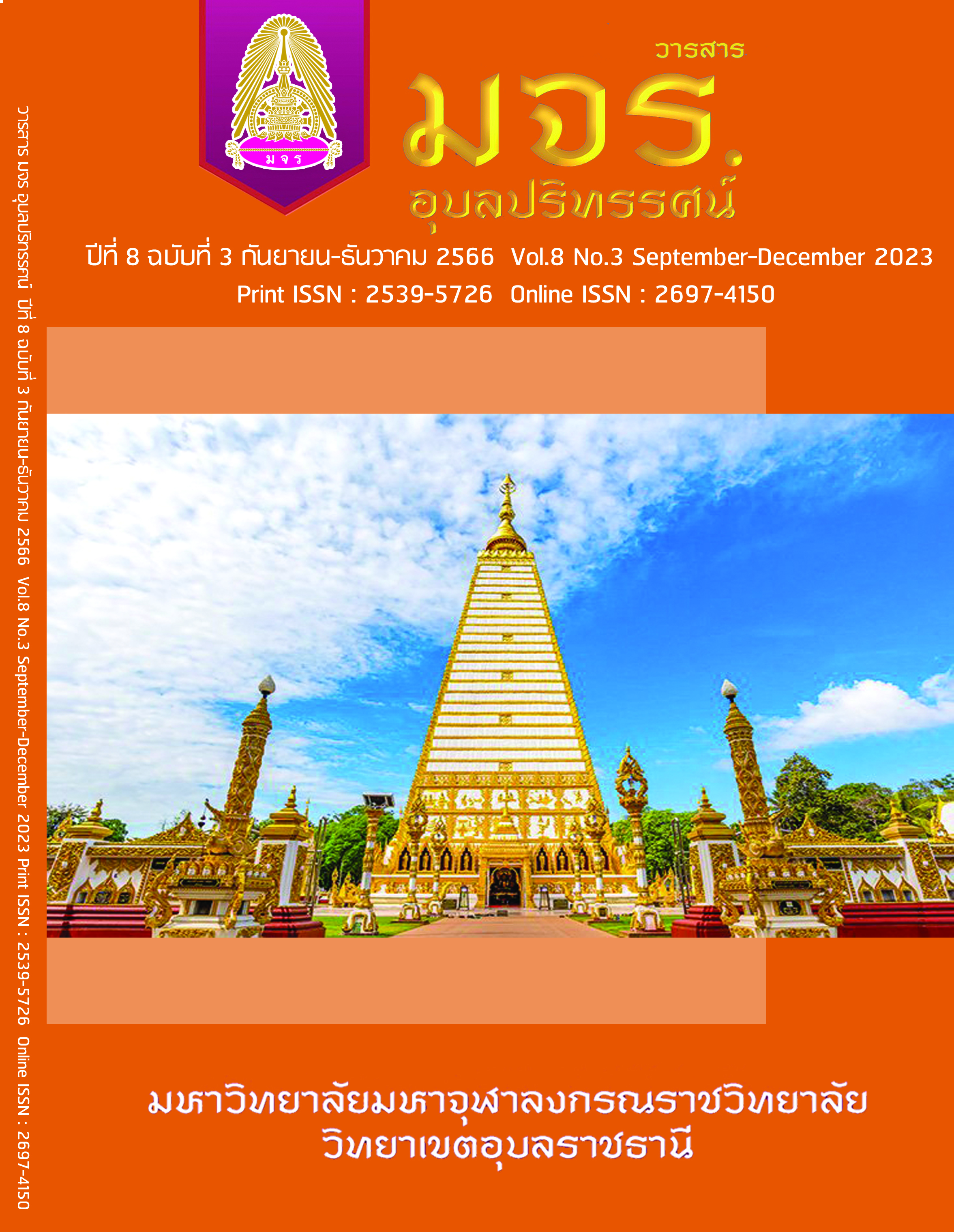BUDDHIST PREORDAINING CEREMONY OF MASTER SAILOM SITSURIN GROUP, TUMBON NONG-ONG, AMPHUR U-THONG, SUPANBURI PROVINCE: COMPONENT, PROCESS, SYMBOLS AND MEANINGS IN RITUAL
Main Article Content
Abstract
This research aims to analyze the components, processes, symbols and meanings in the Buddhist preordaining ceremony of Moh Khwan Sailom Sitsurin group, Tumbon Nong-Ong, Amphur U-Thong, Supanburi province. This is the qualitative research using the concept of ritual and symbol with meaning by analyzing the data group of text and context of Buddhist preordaining ceremony and focus group interview. The study has found that Sailom Sitsurin group still continues the old-fashioned Buddhist preordaining ceremony and creatively applied to the certain local context. There are 6 main components of the ceremony as; 1) the objects or tools for the ritual namely; ritual’s hall, food offerings, worshipping offerings, objects used in ritual namely; Baisri, Baisri’s props, sacred thread, holy water bowl, holy leaves, master’s knife, peak of banana leave bud, banana leave wrapping cloth, rice grain bowl, candle board, white candles, anointing powder, young coconut, boiled eggs to top the Baisri and Gong; and honoring objects, 2) Master or Moh-khwan, 3) manners of ritual’s attendees, 4) rhythm and lyrics in the ritual, 5) duration of the ritual, and 6) role play and dancing. There are 28 processes of the ritual, the important processes are stated as follow; calling upon angels, intonation preaching of 5 khandha, intonation preaching of death and conception, intonation preaching of entering the dream; intonation preaching of dream’s interpretation, intonation preaching of morning sickness, intonation preaching of month order; intonation preaching of traditional birth attendant delivering, parents’ benevolence, calling off souls, intonation preaching to preach the preordained one (naga), bringing in the Baisri and candlelight procession. Symbols in the Buddhist preordaining ceremony are consisted of 1) personal symbols namely; the preordained one, master, the preordained one’s parents and group of performers, 2) objective symbols namely; Baisri, Baisri’s covering cloth, eggs to top on Baisri, Baisri’s props, sacred thread, food offerings, honoring tray with pedestal, holy water, holy leaves, rice grain bowl, banana leave wrapping cloth, candle board, anointing powder, Gong, candles and young coconut, 3) behavioral symbols namely; the respect of Triple Gems, the ordained one laying his head on mother’s lap, candlelight procession, calling off souls, calling for worshipping money, blowing and sweeping smoke, and handing in banana leave wrapping cloth, 4) white symbols, 5) number 3 symbol. The meanings of the symbols are consisted of 1) space symbol of female, 2) the symbolic combination of Buddhism, Brahmanism and animism, 3) filial piety and harmony, 4) Buddhist philosophy, 5) auspiciousness and purity, and 6) symbols of cummunitas. Buddhist preordaining ceremony of Moh Khwansailom Sitsurin group contains the characteristic components and processes. Some processes are abridged and created in order to be appropriate for context and timing while the symbols remain their meanings as the old ritual conventions’ to well convey the meanings linking to thoughts, wisdom, vision, knowledge of both worldly and religiously. These play the role to let the ceremony exist among pop culture current as well as to be an important life part of the good son of Buddhist in the rural central area of Thailand.
Article Details
References
กาญจนา แก้วเทพ. (2560). เครื่องมือทำงานวัฒนธรรมชุมชนและสื่อพิธีกรรมศึกษา.
พิมพ์ครั้งที่ 2. กรุงเทพฯ : ศูนย์มานุษยวิทยาสิรินธร (องค์การมหาชน).
คมลักษณ์ ไชยยะ. (2562). พื้นฐานแนวคิดสัญวิทยาของโรล็องด์ บาร์ตส์. วารสารวิชาการ
มนุษยศาสตร์และสังคมศาสตร์, 7(2), 27-61.
ทิพย์สุดา นัยทรัพย์. (2542). รายงานการวิจัย การศึกษาประเพณีทำขวัญนาคจังหวัดพิษณุโลก.
พิษณุโลก: สถาบันราชภัฏพิบูลสงคราม.
ธนุยุติ แสงสว่าง. (2566). หมอขวัญ คณะหมอขวัญสายลม ศิษย์สุรินทร์. สัมภาษณ์, 20 พฤษภาคม.
บาหยัน อิ่มสำราญ. (2559). วรรณคดีพระราชพิธี. นครปฐม: คณะอักษรศาสตร์ มหาวิทยาลัย
ศิลปากร.
ประจิน ฉะอ้อน. (2566). หมอขวัญหญิง คณะหมอขวัญสายลม ศิษย์สุรินทร์. สัมภาษณ์,
พฤษภาคม.
ประเสริฐ รุนรา. (2562). พระราหู การสืบทอดและการสร้างสรรค์สัญลักษณ์ความเชื่อใน
สังคมไทย. กรุงเทพฯ : สามลดา.
ภาณุพงศ์ อุดมศิลป์. (2565). พิธีกรรม “กินดอง”: การวิเคราะห์บริบทและบทบาทของพิธีกรรมที่
มีต่อชาวบ้านและชุมชนเมืองหนองบัวลำภู. กรุงเทพฯ : สันติศิริการพิมพ์.
ว. จีนประดิษฐ์.(ม.ป.ป.). พิธีการทำขวัญนาค ทำขวัญกฐิน.กรุงเทพฯ: หอสมุดกลาง 09.
ศุภชัย อิ่มทอง. (2566). หัวหน้าคณะหมอขวัญสายลม ศิษย์สุรินทร์. สัมภาษณ์, 20 พฤษภาคม.
สันติชัย แย้มใหม่. (2556). “มายาคติทางเพศสภาพผ่านสัญญะในพิธีโนราโรงครู.” วิทยานิพนธ์
ศิลปศาสตรมหาบัณฑิต สาขาพัฒนามนุษย์และสังคม มหาวิทยาลัยสงขลานครินทร์.
เสฐียรโกเศศ. (2506). ขวัญและประเพณีทำขวัญ. พระนคร: ก้าวหน้า.
อคิน รพีพัฒน์. (2551). วัฒนธรรมคือความหมาย : ทฤษฎีและวิธีการของคลิฟฟอร์ด เกียร์ซ.
กรุงเทพฯ : ศูนย์มานุษยวิทยาสิรินธร (องค์การมหาชน).


